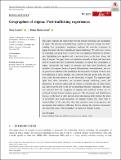Files in this item
Geographies of stigma : post-trafficking experiences
Item metadata
| dc.contributor.author | Laurie, Nina | |
| dc.contributor.author | Richardson, Diane | |
| dc.date.accessioned | 2020-09-17T09:30:02Z | |
| dc.date.available | 2020-09-17T09:30:02Z | |
| dc.date.issued | 2021-03 | |
| dc.identifier | 257703109 | |
| dc.identifier | 3ed54104-ff51-4806-822d-b2117f38169d | |
| dc.identifier | 85091044541 | |
| dc.identifier | 000569718100001 | |
| dc.identifier.citation | Laurie , N & Richardson , D 2021 , ' Geographies of stigma : post-trafficking experiences ' , Transactions of the Institute of British Geographers , vol. 46 , no. 1 , pp. 120-134 . https://doi.org/10.1111/tran.12402 | en |
| dc.identifier.issn | 0020-2754 | |
| dc.identifier.other | ORCID: /0000-0003-0081-1404/work/77525160 | |
| dc.identifier.uri | https://hdl.handle.net/10023/20638 | |
| dc.description | Funding: UK Economic and Social Research Council (Grant Number(s): RES-062-23-1490). | en |
| dc.description.abstract | This paper explores the relationship between human trafficking and geographies of stigma. We introduce post-trafficking contexts as important settings for understanding how geographical imaginaries underpin the everyday occurrence of stigma for those who have experienced human trafficking. We show how a focus on trafficking can speak back to some of the core migration literatures in Geography, highlighting new agendas with a particular focus on the how, where and why of stigma. The paper draws on qualitative research in Nepal and interviews with 46 women who have experienced trafficking, to explain how geographies of stigma circumscribe the agency of returnees and affect their livelihoods and mobilities. It examines themes of spatial differentiation, territorialisation and scalar processes in relation to the production and navigation of stigma. It shows how post-trafficking is given meaning and expressed through spatial form and relations, which become manifest in scalar hierarchies of stigma. The argument highlights how these hierarchies are anchored through trafficking routes and destinations. It contrasts village and city settings as potential sites of return, bringing centre stage the role of the city in mediating returnee’s experiences. The analysis indicates how the categories of migrant and trafficked women are co-produced through bureaucratisation processes. The documents and identificatory practices at the heart of state and non-state interventions help produce the terms of in/visibility and social recognition for migrant women who often want to remain hidden. At the same time, they also reproduce some of the practices and mechanisms that underpin trafficking, thereby shaping the rejection, harassment and abuse that comes with geographies of stigma for returnee women. | |
| dc.format.extent | 15 | |
| dc.format.extent | 326591 | |
| dc.language.iso | eng | |
| dc.relation.ispartof | Transactions of the Institute of British Geographers | en |
| dc.subject | Human trafficking | en |
| dc.subject | Nepal | en |
| dc.subject | Post-trafficking | en |
| dc.subject | Returnee | en |
| dc.subject | Return migration | en |
| dc.subject | Stigma | en |
| dc.subject | Qualitative research | en |
| dc.subject | G Geography (General) | en |
| dc.subject | HM Sociology | en |
| dc.subject | DAS | en |
| dc.subject | BDC | en |
| dc.subject | R2C | en |
| dc.subject | SDG 5 - Gender Equality | en |
| dc.subject | SDG 8 - Decent Work and Economic Growth | en |
| dc.subject | SDG 16 - Peace, Justice and Strong Institutions | en |
| dc.subject.lcc | G1 | en |
| dc.subject.lcc | HM | en |
| dc.title | Geographies of stigma : post-trafficking experiences | en |
| dc.type | Journal article | en |
| dc.contributor.institution | University of St Andrews. Centre for Research into Equality, Diversity & Inclusion | en |
| dc.contributor.institution | University of St Andrews. School of Geography & Sustainable Development | en |
| dc.identifier.doi | 10.1111/tran.12402 | |
| dc.description.status | Peer reviewed | en |
This item appears in the following Collection(s)
Items in the St Andrews Research Repository are protected by copyright, with all rights reserved, unless otherwise indicated.

